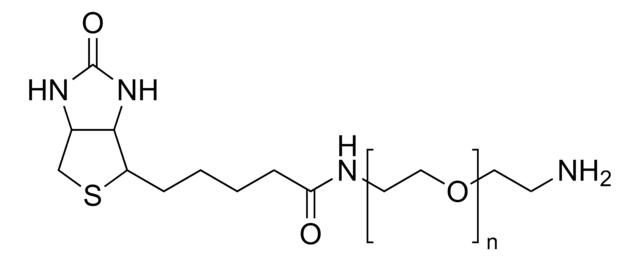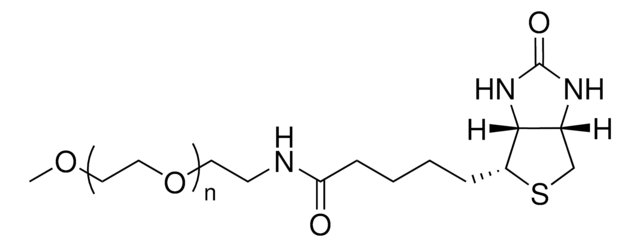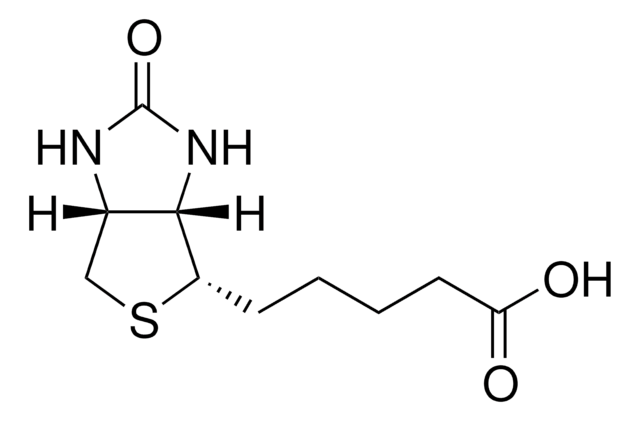B9931
Biotin-poly(ethyleneglycol)amine
>90%, waxy solid
Synonym(s):
Biotin-PEG amine
Sign Into View Organizational & Contract Pricing
All Photos(1)
About This Item
Recommended Products
conjugate
biotin conjugate
Assay
>90%
form
waxy solid
mol wt
average mol wt 720 Da
loss
<7% loss on drying
storage temp.
2-8°C
Application
Biotin-poly(ethyleneglycol)amine (BPEG) is used to functionalize (biotin pegylate) surfaces of structures such as hydrogels, microspheres, quantum dots and nanoparticles to take advantage of biotin-avidin based targeting.
Biotin-poly(ethyleneglycol)amine may be used as a crosslink horse radish peroxide (HRP) enzyme to the surface of silver island films (SIFs). 1 Biotin PEG amine may be used to functionalize the surface of poly(lactic-co-glycolic acid) (PLGA) nanoparticles.
Storage Class Code
13 - Non Combustible Solids
WGK
WGK 3
Flash Point(F)
Not applicable
Flash Point(C)
Not applicable
Personal Protective Equipment
dust mask type N95 (US), Eyeshields, Gloves
Regulatory Information
新产品
Choose from one of the most recent versions:
Already Own This Product?
Find documentation for the products that you have recently purchased in the Document Library.
Jason D Clapper et al.
Biomacromolecules, 9(4), 1188-1194 (2008-03-01)
We describe the synthesis of a novel biotinylated nanotextured degradable hydrogel that can be rapidly surface engineered with a diverse range of biotinylated moieties. The hydrogel is synthesized by reacting methacrylated biotin-PEG with dimethacrylated P LA-b- PEG-b-P LA (LPLDMA, PEG
Bioengineering approaches to controlled protein delivery.
Kobsa S and Saltzman WM
Pediatric Research, 63(5), 513-519 (2008)
Mauro Pignatto et al.
Bioconjugate chemistry, 21(7), 1254-1263 (2010-06-10)
Avidin was recently found to display the ability to interact with high affinity with nucleic acids. In this work, we investigated how this property is affected by the protein modification with poly(ethylene glycol) (PEG). More precisely, we studied the influence
A Kurihara et al.
Bioconjugate chemistry, 11(3), 380-386 (2000-05-23)
The amyloid plaques of Alzheimer's disease (AD) are formed by the neuropeptide Abeta(1)(-)(42/43), and carboxyl terminal truncated forms of this neuropeptide, designated Abeta(1)(-)(40), bind to amyloid plaques of AD autopsy tissue sections. Therefore, Abeta(1)(-)(40) is a potential peptide radiopharmaceutical that
Our team of scientists has experience in all areas of research including Life Science, Material Science, Chemical Synthesis, Chromatography, Analytical and many others.
Contact Technical Service







